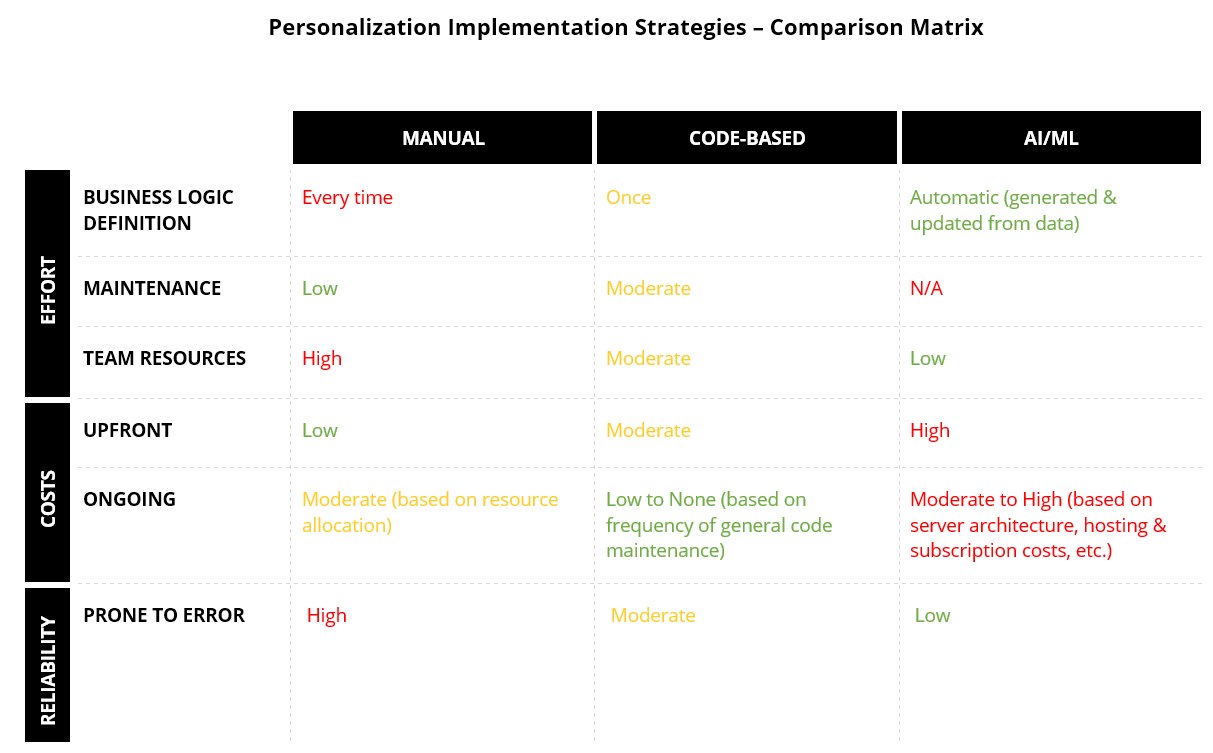How to Choose the Right Personalization Implementation Strategy for Your Website

When it comes to the implementation of personalization, there are three different strategies to consider, each with its own pros and cons. These are high-level categorizations of personalization solutions based on how the business logic is implemented. You’ll find that the determining factors in choosing a strategy that is best suited to your needs are your team’s capabilities, relative costs, effort and resources involved, and the goals for this personalization initiative.
We recommended a “crawl-walk-run” approach when it comes to personalization and, although all these implementation types can be used in any of those stages, the manual option is more suited for starting out than the others. Below, we’ll delve into these personalization implementation strategies in more depth. We've also included a table at the end of this post that summarizes the pros and cons of each method.
3 Types of Personalization Implementation Strategies
Manual
Manual personalization is when a business user defines which call-to-action should be presented to a website visitor based on information about them. This is a common out-of-the-box feature in many technologies that provide personalization. In this scenario, a business user defines the logic, usually through a set of coded rules, for each instance of personalization.
Unfortunately, it inherently places an extra work load on the people that need to define the business logic for each of these personalized instances. Because of this, it is prone to error and more time consuming. When individual resources are responsible for defining the logic every time, it can be configured incorrectly more often than the other options, but this same principle also makes it easy to change. If you discover that the logic is inaccurate or not creating the desired increase in your KPI, you can change it just as easily as you created it.
For these reasons, this can be the best method when you’re still trying to clearly identify your audience segments and what they best respond to, i.e. you’re in the “crawl” phase of personalization. It works well as long as you have the necessary bandwidth on your team.
Based on the above, manual personalization is best suited to short-term, one-off instances such as events and marketing campaigns. A great use case would be to incorporate a banner component on top of a homepage for people visiting the site from a conference (based on their zip code or access URL) and showcase a personalized message that would be pertinent to them.
Code-Based
A code-based personalization implementation strategy involves the business logic being set in code, without a user needing to specify it for a given instance. This method often takes the form of “recommended for you” or “near you” sections that aren’t manually defined for groups of users. Rather, they are systematically populated based on certain criteria which includes visitor information like browsing, search and purchase history, location, etc.
This approach requires that the logic for the desired outcome be well-defined beforehand. As this logic is defined in the code, it comes with some additional up-front development costs on top of your technology costs. You’ll also have to involve your development team if the logic ever needs to be changed, which is why it’s so important to ensure that it is carefully thought through in the beginning.
The biggest benefits of this method are that it doesn’t require any extra effort from your business resources after the initial setup and is less error-prone. For instance, once the code for the “recommended for you” section is completed, you can reasonably use that section on every page without having to define the logic each time.
For this reason, if you have a small or overworked team without the time or training needed to define the logic manually, this is often the best approach for you. As an example, in a large health system, being able to surface related doctor profile pages based on a patient visiting certain clinic location pages on the site would take months to set up manually given the extremely large number of possible permutations. Code-based personalization would work well in this scenario.
Pattern matching data from browser history combined with site searches for specific medical conditions makes it possible to surface relevant, personalized results.
Given the sensitivity of health systems data, personalized results would be included as part of a randomized display rather than on their own, to provide a degree of privacy while still adding value to users.
Artificial Intelligence/Machine Learning
An Artificial Intelligence (AI) or Machine Learning (ML) personalization implementation strategy entrusts the business logic to an algorithm designed to regularly improve upon itself. This usually looks like a blank space in an email or website where the technology decides what content to include there for the reader given a pool of options. In this scenario, a business user doesn’t have to do much more than define that space and the available pool of content. Thus, this option requires the least amount of time from your team and is also less prone to error.
The different AI/ML options on the market all follow a similar principle in that the software is constantly keeping its own set of analytics data on the outcomes of various combinations of content and user data to determine what combinations result in the highest conversions. It might take a year to define one thousand different data and content combinations manually, months to code business logic for all those combinations, or mere seconds for one of these solutions. The more data you can provide to AI/ML systems, the more accurate they become.
So, for example, customer data and the current weather at visitors’ locations (obtained through APIs) could improve the function of AI/ML personalization implementations for a business in the travel industry. This would allow the company to entice website visitors who are currently experiencing a blizzard with cruises to tropical destinations. Such personalization would be tedious to implement manually but is far more viable with AI/ML.
AI/ML implementations come at a higher initial investment cost than the manual or code-based options and will require some training to use effectively. However, if your organization can justify the price of these solutions, they can significantly move measured KPIs without adding much burden to the content team.
Below is a table that provides a summary view of the various factors described above for each method. Each factor is evaluated on a least desirable to most desirable (red to green) scale to give you a sense of how these approaches stack up against one another.

Explore the Best Personalization Implementation Strategy for Your Website
Are you contemplating implementing personalization for your website? We’re happy to share what we’ve found to be immensely helpful for our clients in their related personalization endeavors and can answer any questions you may have. Feel free to reach out to us directly at [email protected] or tweet us - @Velir.



